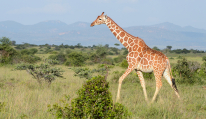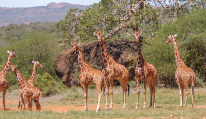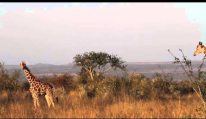Social Structure
The social structure of giraffes is very fluid. Herd composition changes constantly, regardless of sex or age, as individuals leave and rejoin groups. The number of giraffes in a herd also varies greatly, reaching as many as 240. Males live a mostly solitary life, though some form bachelor herds.
Communication
Giraffes occasionally utter grunts, whistles, snorts, and other noises, particularly when they are under stress.
Behavior
Giraffes are active day and night. In the early morning and evenings, they spend their time feeding and walking; during the heat of the day, they rest and ruminate. Giraffes are not territorial, though they do have home ranges where they spend most of their time. Male giraffes engage in a behavior called necking, where they use their heavy skulls to bash into one another’s sides. This display, which can be extremely violent, is used to assert dominance.
Conservation
The overall giraffe population has been declining due to poaching, habitat loss, and expanding human activity. To keep the count from dwindling further, there has been an effort to increase the number of giraffes living in parks, game reserves, and other protected areas.






















